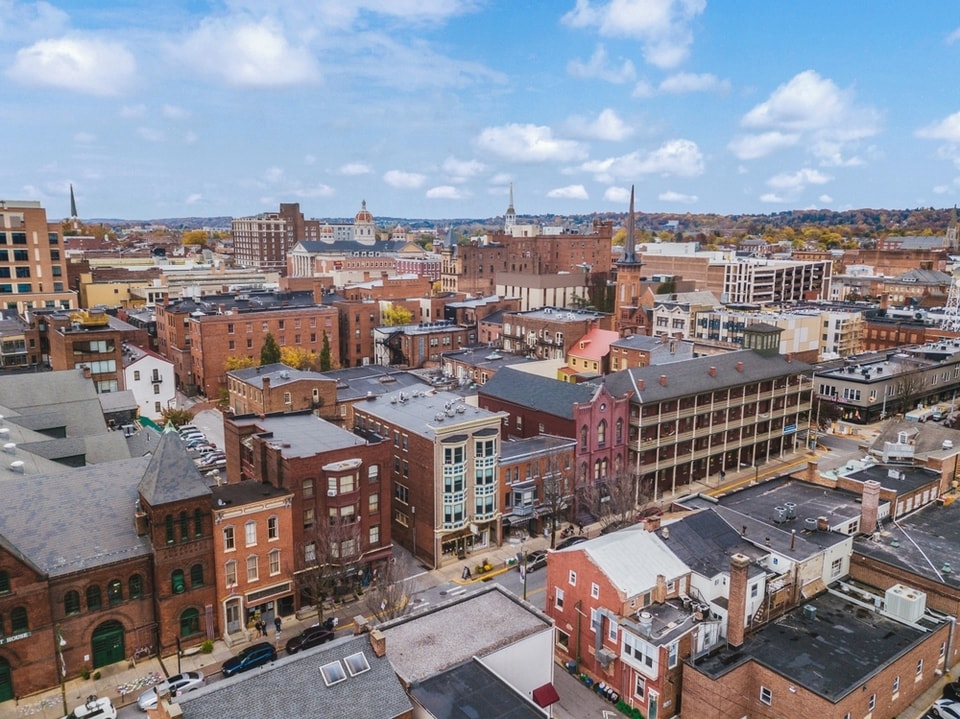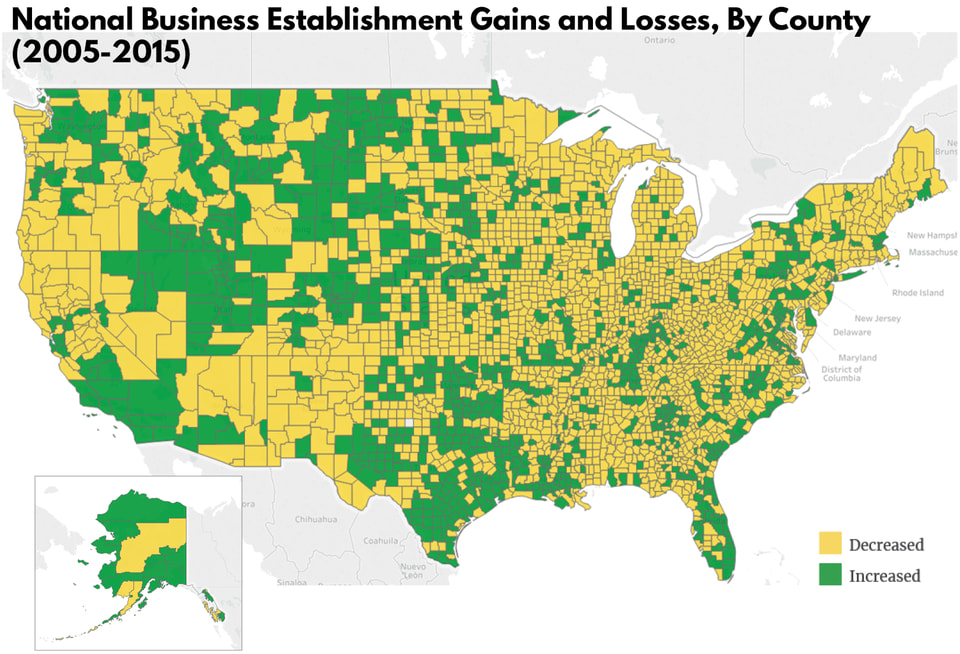Memo Published March 27, 2019 · 7 minute read
What to Do with Places Left Behind?
Ryan Bhandari

There is an opportunity crisis in America. As proof, look no further than the 2,100 counties that lost 200,000 businesses between 2005 and 2015—and 1.2 million private sector jobs along with that. These urban, suburban, and rural areas are home to white, African American, Asian, Hispanic, and Native American families. And they are leaking opportunity.
As the divide between high-flying and distressed communities continues to grow, voters will demand solutions to bring more opportunity to more places. Below, we offer a series of options ranging from transforming how entrepreneurs can start and grow businesses where they live to better connecting every community to the digital economy.
Anyone running for nationwide office in 2020 needs to confront the opportunity crisis head on. As a central part of that, policymakers need to make sure that we are investing in places left behind—transforming them and the families that live there.
The Case
Everyone should be able to earn a good life where they live. Unfortunately, that is simply not possible in too many communities across the country.
Voters aren’t feeling economically secure where they live. Our polling asked people whether a 17 year old would have more opportunity if they stayed in their community or moved. By a whopping 24 points, people said a young person would need to move to find opportunity.1 And yet in small towns and rural areas, it’s far worse. By nearly 50 points, they say a young person would need to move to get opportunity.
The majority of US counties are losing businesses. From 2005 to 2015, 1/3 of the counties across the US saw substantial business growth—adding 350,000 businesses and 6.7 million private sector jobs2. Yet, as noted above, during the same decade, 2/3 of US counties lost 200,000 business and 1.2 million private sector jobs along with it.3

Most venture capital funding is concentrated in three states. Good ideas are not confined to Silicon Valley or Manhattan. But you wouldn’t know that from looking at where venture capital goes. In 2015, nearly four out of every five venture capital dollars were invested in just three states: California, New York, and Massachusetts. This is compared to 50% in 1995.4 In 2014, seven states accounted for 50% of all startups, and half all of patents were filed in just 50 counties.5
Trade and globalization hit certain areas harder than others. As the US has transitioned to a service-based knowledge economy, the disruption for those employed in traditional manufacturing has been particularly painful. The places most heavily dependent on manufacturing were doing the best in 1980, but in 2016, those areas were among the lowest performing regions in the entire country based on measures of vitality compiled by the Brookings Institution.6
Minority communities continue to face steep challenges. The legacies of institutionalized racism and discrimination along with unequal educational opportunities, criminal justice disparities, and other issues have prevented particular places and communities from achieving their full potential. Our analysis of job quality in 200 metro areas in the US shows that the larger the minority population, the less opportunity there is for that community to earn a good life.7
It’s not as easy for people to simply move toward opportunity. Americans are moving far less than they used to. The percentage of people moving to another state in a given year halved from 1980 to now. A recent Third Way report explains the factors that have caused this decline. These include a steady rise in restrictive occupational licensing rules, benefits that don’t cross state lines, and housing in the most productive cities that is often prohibitively expensive.8
Possible Solutions
There are numerous ways to invest in places left behind throughout the country. Here are a select few:
The Opportunity Bank
Third Way has proposed a new effort to unleash $1 trillion in new small business and start up lending over the coming decade. To accomplish this, the Opportunity Bank would quadruple the cap of the SBA’s 7a loan guarantee program as well as lower the fees, increase guarantee amounts, and expand the pool of capital for eligible entrepreneurs and small business owners.9
The Opportunity Fund
Third Way has also proposed ensuring that entrepreneurs in every state have access to private sector equity investment. Under this proposal, the federal government would grant seed capital to states which can either partner with local venture capital firms or hire their own team to invest money in homegrown entrepreneurs with high-growth potential.
10-20-30 Plan
Representative James Clyburn proposed an innovative way to fight persistent poverty in communities all over America. His plan mandates that 10% of federal funds for specific government programs go to communities in which 20% or more of the population have lived below poverty for the last 30 years.10
Broadband for All
Third Way has proposed to connect everyone in the country to broadband through two sweeping actions. First, a Broadband Construction Surge will provide $45 billion in federal funds for building out broadband connectivity to hard-to-serve areas and tear down barriers to construction. Second, an Automatic Access program will automatically enroll low-income families in discounted broadband support and support the purchase of low-cost computers.11
Place-based automatic stabilizers
This proposal from the Brookings Institution would reform the way the federal government distributes money to states during both a recession and a recovery. It would tie the size of federal grants to the economic needs of the state as opposed to things like population and size. It would also send more money to states during a recession to help shore up their budgets.12
Housing Reform
This proposal from Senator Elizabeth Warren and confirmed by independent analysis from Moody’s Analytics, would increase the supply of housing in expensive metropolitan areas across the country by creating federal incentives for cities to reform restrictive zoning laws and investing billions in the construction of affordable housing. The proposal also provides grants to low-income home owners who need a down-payment and expands the Fair Housing Act.13
Infrastructure Development
As Democrats proposed in their Better Deal package, we need a huge commitment to revitalize our nation’s infrastructure. In this plan, $1 trillion was dedicated to roads and transit, telecommunications, passenger rail, schools, airports, water, and energy infrastructure. We must ensure there is also a strong commitment to rural areas that often have very pressing demands for infrastructure development.14
Re-employment Insurance
This Third Way proposal would completely revamp the traditional unemployment insurance system and help more workers jump back into the workforce. Laid-off workers would continue to receive traditional income support, but they would also be eligible for a series of other modernized benefits. These include a universal training voucher, a job search stipend, and wage insurance for older workers.15
Licensing Reform
This proposal from the Brookings Institution would offer states financial incentives to reform the way they license professions. It would also make it easier for licensed professionals to cross state lines for a new job and possibly reduce the number of occupations subject to licensing moving forward. Third Way also has a proposal that would create a set of national, uniform licensing standards for occupations that employ a lot of veterans. Veterans often find themselves locked out of certain professions when they transition back into the civilian workforce because they lack the proper license.16
Rural Commuter’s Credit
For workers in rural communities that are often far away from economic activity, this proposal from Aspen Institute would provide them with a tax credit that reimburses workers for their commuting costs. It would be administered by local government employment centers and the exact amount given out would vary based on each worker’s unique commuting costs.17
Rural Development
Small Business Majority, as part of its recommendations to boost rural entrepreneurs, calls for permanent funding for USDA programs like the Rural Microentrepreneur Assistance Program, Value-Added Producer Grants, and the Intermediary Relending Program that support rural entrepreneurs. 18
Online Financing
Another proposal from Small Business Majority would expand the reach of online resources and lending platforms to fill gaps for rural entrepreneurs that have seen their access to traditional brick and mortar financial institutions restricted. This would have to coincide though with increased transparency and regulation of online lending to protect against predatory loans.19
Bio Based Manufacturing Support
This proposal from Tom Vilsack in Democracy would help support agricultural businesses in rural America by providing publicly financed research for new bio based manufacturing techniques that take plants, crops, and animal waste and converts them into chemicals, fabrics, fibers, and energy.20
